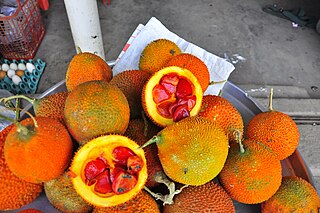This page is based on this
Wikipedia article Text is available under the
CC BY-SA 4.0 license; additional terms may apply.
Images, videos and audio are available under their respective licenses.

Gourds include the fruits of some flowering plant species in the family Cucurbitaceae, particularly Cucurbita and Lagenaria. The term refers to a number of species and subspecies, many with hard shells, and some without. One of the earliest domesticated types of plants, subspecies of the bottle gourd, Lagenaria siceraria, have been discovered in archaeological sites dating from as early as 13,000 BC. Gourds have had numerous uses throughout history, including as tools, musical instruments, objects of art, film, and food.

Momordica charantia is a tropical and subtropical vine of the family Cucurbitaceae, widely grown in Asia, Africa, and the Caribbean for its edible fruit. Its many varieties differ substantially in the shape and bitterness of the fruit.
Balsam apple may refer to:

Gấc is a type of perennial melon grown throughout Southeast Asian countries and Northeastern Australia. Gấc is notable for its orange-reddish color resulting from its rich content of beta-carotene and lycopene.

Momordicin I, or 3,7,23-trihydroxycucurbitan-5,24-dien-19-al, is a chemical compound found in the leaves of the bitter melon vine, possibly responsible for its reputed medicinal properties.
Momordicin is one of several compounds found in the bitter melon vine, including:
Momordicoside is any of several related cucurbitane triterpenoid glycosides that can be extracted from the bitter melon vine (Momordica charantia). They include:
Goyaglycoside is any of several related triterpenoid glycosides found in the fruits bitter melon vine, called goya in Okinawan language. They include:
Karaviloside is any of several related cucurbitane triterpenoid glycosides found in bitter melon vine. They include:

Balsaminol B or 7β-methoxycucurbita-5,24-diene-3β,23(R),29-triol, is a chemical compound with formula C
31H
52O
4, found in the balsam apple vine. It is a cucurbitane-type triterpenoid, related to cucurbitacin, isolated by C. Ramalhete and others in 2009.

Cucurbalsaminol A or cucurbita-5,23(E)-diene-3β,12β,25-triol, is a chemical compound with formula C
30H
50O
4, found in the Balsam apple vine. It is a cucurbitane-type triterpenoid, related to cucurbitacin, isolated by C. Ramalhete and others in 2009.

Momordica foetida is a perennial climbing vine native of tropical Africa, closely related to the bitter melon and balsam apple. Its species name ("bad-smelling") refers to its unpleasant smell. It was previously named M. morkorra and M. cordata (Cogn.)
Charantin is a chemical substance obtained from the Asian bitter melon, reputed to be responsible for the hypoglycaemic properties of those plants. It was identified by Lolitkar and Rao in 1960. It was also found in the similar African species M. foetida, by A. Olaniyi in 1975, under the name foetidin.

Momordica cymbalaria is a vine of the Momordica genus found in the Indian states of Andhra Pradesh, Karnataka, Madhya Pradesh,
Maharashtra and Tamil Nadu. It is used in the local folk medicine as an abortifacient and for the treatment of diabetes mellitus. It is a relative of the bitter melon plant which is also used against diabetes. The plant has also been named Luffa tuberosa (Roxb.) or Momordica tuberosa (Roxb.)
A kuguaglycoside is one of several chemical compounds isolated from the roots of the bitter melon vine by J.-C. Chen and others.
A kuguacin is one of several chemical compounds isolated from the bitter melon vine by J.-C. Chen and others.
A momordicine is any of several compounds found the bitter melon vine, Momordica charantia. They are glycosides of cucurbitane derivatives. They include

Neokuguaglucoside is a chemical compound with formula C
42H
66O
14, isolated from the fruit of the bitter melon vine, where it occurs at 23 mg/35 kg. It is a triterpene glucoside with the cucurbitane skeleton. It is a white powder, soluble in methanol and butanol.









